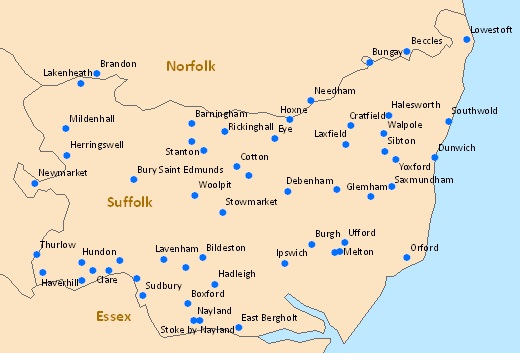 |
Home | Royal/State | Colonial/British States etc | Tokens | Articles & Documents | Bibliography |  |
17th-Century Farthing Trade Tokens
Suffolk
From "The Coinage of Suffolk" is extracted the information contained in the following preface to the series, and we cannot too fully express our indebtedness to so valued a sub-editor as Mr. Golding has in effect been for this county. With reference to the interesting devices which form a feature of Suffolk tokens, we notice that the principal edifices in the towns were frequently adopted as a device by the issuers, and in this county we notice the castles of Bungay and Framlingham, the market-cross at St Edmund's Bury, and the sheep-pen at Beccles. The armorial bearings of various families, with or without their crests, are also chosen as devices. In the following list are those of Crane, of Beccles; Baythorne, of Bury; Elliston, of Clare; Ray, of Laxfield; Skinner, of Sudbury; Knights, of Saxmundham; and others. Merchants' marks, curious trade devices, and other designs are also met with, as examples of which see Richard Prime, of Bury; Stephen Green, of Ipswich; Samuel Fitch, of Rickinghall. Inns and taverns were well represented by their various signs. In the following list are to be found those of the Ship, Lion, Sun, Angel, Rose, Crown, Waggon, Hare, Griffin, Pickerel, Woolpack, Star, Halfmoon, Eagle, Falcon, King's Head, Greyhound, Royal Oak, Seven Stars, Hard, Cock, Anchor, Three Tuns, Swan, St George and the Dragon, and others, many of which are still the principal places of resort at the present day, and many have remained nearly unaltered in the towns for a period of more than two centuries. The trades of Suffolk, consisting then of weaving and the manufacture of woollen cloth (introuced by the Flemings, who settled in this county in large numbers), serge, hempen cloth, and baize, gave employment to many of the population. These trades are shown by the tokens, as, in addition to a roll of cloth, a shuttle, and a bale of wool, we have the Arms of the Clothworkers, the Drapers, the Haberdashers, and the Merchant Tailors' Companies. Others in trade give examples of their cheif implements or occupation; thus, on a butcher's token, there is an axe; on a tallow-chandler's, a man dipping candles; on a gardener's, a nunch of grapes; on a cordwainer's, a shoe; on a vintner's a barrel, on which is seated a boy; on a baker's, his peel; on a bootmaker's, a leg with high boots; on a maltster's, a bushel measure; on another baker's, three rolls of bread; and so on. The armorial insignia of the various Companies of the Brewers, Bricklayers, Fishmongers, Bakers, Apothecaries, Skinners, Chandlers, Mercers, Ironmongers, Grocers, and others, also frequently appear. On a few there are punning devices on the issuers' names; as Crosse, of Clare, gives a cross pat&eactute;e; Shipp, of Needham, a ship; Rozer, of the same place, a rose; whilst some show the justice of their dealings by a pair of scales equally balanced, and one issuer, to impress the fact more fully, declares himself to be "honest" George Turner. One piece bears the singular inscription, "WE 3 SISTERS. The most numerous are the farthing and halfpenny tokens; the pennies are few, only three being at present known. The tokens of Saxmundham, Walpole, Woodbridge and Yoxford appear to be double farthing tokens, and as such are unusual forms of the halfpenny token. The tokens of Suffolk are generally round; but there are also square, heart-shaped, and octagonal ones among them. The number of tokens issued by the traders and corporations of the county of Suffolk here described are three hundred and seventy-five in number [not all are farthings, though, so not all included here], which were issued in about seventy different towns and villages. The earliest date in the series is 1648, and the latest 1671. The series as a whole is a very large and important one, and possesses very many points of special interest. Many of the notes will be found to be of unusual importance.
|

Custom Search
|
Privacy Policy - Contact - Home
© 2007-2021 BritishFarthings
